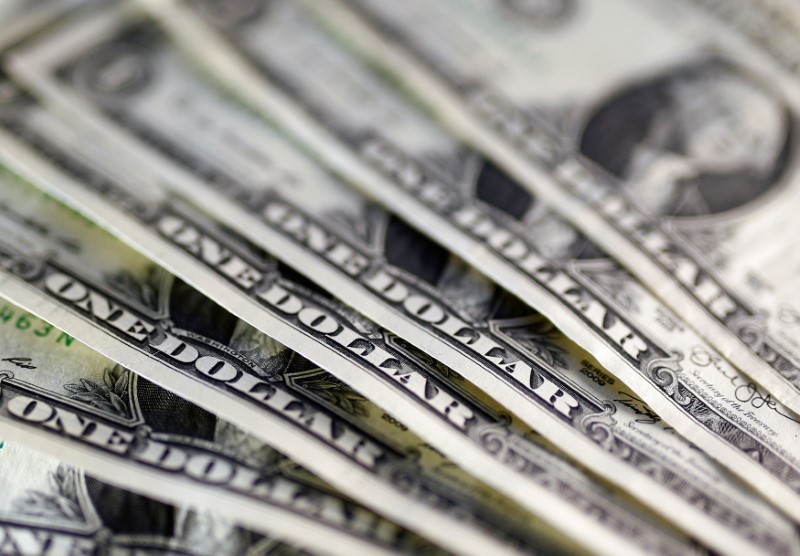Forex - U.S. Dollar Falls as Consumer Sentiment Surprisingly Slips - Investing.com
Forex - U.S. Dollar Falls as Consumer Sentiment Surprisingly Slips - Investing.com |
- Forex - U.S. Dollar Falls as Consumer Sentiment Surprisingly Slips - Investing.com
- Forex - U.S. Dollar Rises as China Comments Ease Tensions - Investing.com
- 3 Things Under the Radar This Week By Investing.com - Investing.com
| Forex - U.S. Dollar Falls as Consumer Sentiment Surprisingly Slips - Investing.com Posted: 30 Aug 2019 07:53 AM PDT  © Reuters. © Reuters.Investing.com - The U.S. dollar fell Friday after consumer sentiment declined to its lowest level since October 2016 as U.S.-China tariff concerns hit domestic spending. The University of Michigan's for August came in at 89.8, which was below expectations for a reading of 92.3. The lower final reading was mainly due to tariff concerns, said Richard Curtin, chief economist in charge of the survey. "Unlike the repeated tariff reversals, negative trends in consumer sentiment cannot be easily reversed," he said. Large moves between the preliminary and final Michigan sentiment numbers for one month are unusual. The , which measures the greenback's strength against a basket of six major currencies, was at 98.442 as of 10:40 AM ET (14:40 GMT), not far from an earlier low of 98.380. The Japanese yen, which is seen as a safe haven in times of market turmoil, rose, with falling 0.3% to 106.15. Meanwhile, U.S. President Donald Trump lamented the euro falling against the dollar as he once again criticized the Federal Reserve for not cutting rates as much as he would like. "The Euro is dropping against the Dollar "like crazy," giving them a big export and manufacturing advantage...and the Fed does NOTHING!" Trump tweeted. Disclaimer: Fusion Media would like to remind you that the data contained in this website is not necessarily real-time nor accurate. All CFDs (stocks, indexes, futures) and Forex prices are not provided by exchanges but rather by market makers, and so prices may not be accurate and may differ from the actual market price, meaning prices are indicative and not appropriate for trading purposes. Therefore Fusion Media doesn`t bear any responsibility for any trading losses you might incur as a result of using this data. Fusion Media or anyone involved with Fusion Media will not accept any liability for loss or damage as a result of reliance on the information including data, quotes, charts and buy/sell signals contained within this website. Please be fully informed regarding the risks and costs associated with trading the financial markets, it is one of the riskiest investment forms possible. |
| Forex - U.S. Dollar Rises as China Comments Ease Tensions - Investing.com Posted: 29 Aug 2019 08:34 AM PDT  © Reuters. © Reuters.Investing.com - The U.S. dollar was higher on Thursday as U.S. economic growth slowed as expected and comments from China helped ease trade war tensions. Chinese officials confirmed on Thursday that they are working with the U.S. to schedule talks in September. Chinese ministry spokesperson Gao Feng said the discussions should focus on preventing escalations and resolving trade issues calmly, which reassured investors that there will be no further escalations. Still, the comments have failed to stop the latest series of U.S. tariffs on Chinese goods from being imposed over the weekend. Meanwhile, second-quarter U.S. GDP was revised lower to 2%, as expected. The data confirms that the U.S. economy remains solid even in the face of trade uncertainty. The Federal Reserve is expected to cut rates by 25 basis points in September to support the economy in the face of trade risk. After the data, U.S. President Donald Trump once again criticized the Fed for not cutting rates enough. "The Economy is doing GREAT, with tremendous upside potential! If the Fed would do what they should, we are a Rocket upward!" he said. The , which measures the greenback's strength against a basket of six major currencies, rose 0.3% to 98.368 as of 11:15 AM ET (15:15 GMT). The Japanese yen, which is seen as a safe haven in times of market turmoil, fell with rising 0.3% to 106.45. Elsewhere, fell 0.1% to 1.2195 while was down 0.2% to 1.1058. Disclaimer: Fusion Media would like to remind you that the data contained in this website is not necessarily real-time nor accurate. All CFDs (stocks, indexes, futures) and Forex prices are not provided by exchanges but rather by market makers, and so prices may not be accurate and may differ from the actual market price, meaning prices are indicative and not appropriate for trading purposes. Therefore Fusion Media doesn`t bear any responsibility for any trading losses you might incur as a result of using this data. Fusion Media or anyone involved with Fusion Media will not accept any liability for loss or damage as a result of reliance on the information including data, quotes, charts and buy/sell signals contained within this website. Please be fully informed regarding the risks and costs associated with trading the financial markets, it is one of the riskiest investment forms possible. |
| 3 Things Under the Radar This Week By Investing.com - Investing.com Posted: 31 Aug 2019 01:38 AM PDT  © Reuters. © Reuters.Investing.com - Here are three things that fell under the radar this week 1. Bitcoin Bulls Squirm as Popular Indicator Flashes 'Sell' Some blame the bitcoin whales. Others blame constant bashing by lawmakers. But this week could be traced to fear about lines on a chart signaling it may be time to run for the exits. Bitcoin's weekly moving average convergence divergence (MACD) histogram – used to determine whether a bullish or bearish move is strengthening or weakening – fell below zero, signaling the start of a downward trend for the first time since February. But the MACD, the difference between a 26-day and 12-day exponential moving average of closing prices, is not without its faults. Like all moving averages, the MACD is a lagging indicator. Some learned this the hard way. During its previous bull run from around January 2015, bitcoin recorded several pullbacks that coincided with the MACD flagging bearish trends, but that turned out to be nothing more than a bear trap, as the popular crypto surged to $20,000 at the end of 2017. With the MACD flashing 'sell' once again, cries of "bear trap" are not without merit as bitcoin is still holding onto its bull run, with gains of more than 150% since the start of the year. Still, the squiggly lines on a chart that signal buy or sell have earned their place in the crypto market, in which fundamental reasons for wild swings are sorely lacking. Underscoring the dearth of fundamental reasons for moves in the crypto market, it is not uncommon for even the most prominent bitcoin watchers to point fingers at BTC whales – big-time traders with huge bitcoin holdings that, when deployed, can cause ripples. Days before moved above $5,000 in April earlier this year, Fundstrat Global Advisors head of research, Thomas Lee, attributed the climb to the return of "old whales." "Bitcoin had a rough 2018 and for much of 2019, it's been steadily climbing and from what we can gather, it's because there have been positive things taking place," Lee said. "You know a lot of the old whale wallets are buying bitcoin so it's been slow accumulation." 2. Markets Still Struggling to Match Last Year Here's a thought that should give pause: Despite this year's gains (16.7% for the , 13.2% for the and 19.7% for the ), the stock market overall is actually below the peaks of the fall of 2018. So, though the major indexes are only 3% or so below peaks reached in July, the S&P 500 is also off 3% from its 2018 peak, while the Dow is off 2% and the Nasdaq is down 2.3%. That's how ugly the late 2018 slump really was. Traders saw a loss of 20.2% for the S&P 500 from its peak in September, 19.4% for the Dow from its peak in early October and nearly 24% for the Nasdaq from its peak in late August. Moreover, the peaks this summer only modestly passed last year's highs before falling back. Other pieces of the market aren't doing so well, at least on a relative basis. The index is trading 12.6% below its peak in September 2018. The index is off 14% from its 2018 peak reached on August 31. The index is still down 16% from its 2018 peak on Oct. 1. There's an irony in that number. Forty-three health care companies have gone public this year, the most of any sector, according to Renaissance Capital data. The index is off nearly 60% from its 52-week high. That probably has a lot to do with falling more than 17% since peaking in April. Bankruptcies are rising among oil-and-gas production companies, The Wall Street Journal reported Friday. The problem is too much debt. Now autumn is coming, often the most volatile time of the year. And the problems that have caused the current malaise – U.S.-China trade tensions, slowing business investment, slowing European economies and the probability of a messy U.K. departure from the EU – haven't gone way. 3. Germany's Trade Problems Aren't About Tariffs WorriesThe stock market has been at the mercy of trade headlines for a while. The primary issue is, of course, China and the U.S., but President Donald Trump has also targeted other trade partners. Just on Friday, he complained about the European Union's currency advantage and took the opportunity to rail against his own central bank at the same time. In the EU, its economic engine, Germany, is in trouble. German came in at 0.1% earlier this month and are struggling. But for all the tariff saber-rattling, the problem may be closer to home: Brexit. German exports to the U.S. rose from April to June, but sales to the U.K. tanked, according to a Reuters report. Exports to the U.K. fell nearly 15% compared to the same period a year ago, Reuters reported, citing trade figures form the Federal Statistics Office. That was compared to a jump of 6% in the first quarter when a Brexit deal still seemed possible. |
| You are subscribed to email updates from "investing forex" - Google News. To stop receiving these emails, you may unsubscribe now. | Email delivery powered by Google |
| Google, 1600 Amphitheatre Parkway, Mountain View, CA 94043, United States | |
Comments
Post a Comment